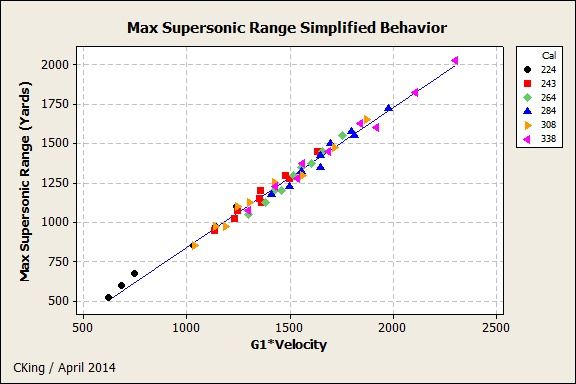As shooters we are always seeking to maximize long range performance, whether it be during the selection of the "best" caliber, bullet weight, BC, tweaking out the highest velocity, etc. I decided to take a high-level view of the options to gain a better perspective of the relative importance of a few of these factors. So I ran a range of cases in JBM across a range of calibers (224 - 338), bullets (low to high BC for each caliber), and velocity (2500, 2750, and 3000 fps). These were evaluated at a nominal atmospheric condition. While the calculations were carried out using the G7 ballistic coefficient to potentially achieve improved predictability, the following summaries will involve G1 which is more readily available for a wider range of bullets.
One of the factors which can be used to distinguish overall performance is maximum supersonic range, at which point accuracy can suffer as the bullet velocity breaks below the speed of sound. In addition the drop and windage characteristics will relate to this as well (more on the in the future)
A following plot shows the importance of BC and velocity; whereby the caliber and weight of the bullet do not have an independent effect on performance (only as these effect the BC)! You have probably read or heard something like this, and perhaps did not completely believe it, but the graph makes this clear:

Based on the appearance of the non-parallel lines representing the different velocities, this can be simplified further by taking the product of G1 x Velocity to obtain a new parameter which represents both these important factors to achieve the following:

Now you see the unique relationship between performance and G1 x Velocity, regardless of caliber (which contains three different bullet weights as well). While a formula can be given to describe this exactly, the interesting point is G1 X Velocity(fps) is approximately the max supersonic range (and would be at a higher altitude and temperature) For example a bullet with G1=0.500 at a velocity of 3000 fps will have an approximate max supersonic range of 0.5 x 3000 = 1500 yards, which you can see is close on the graph. So when you want to make a relative comparison of bullets, calibers, velocities, options, etc this is a simple calculation to get meaningful results without running all the ballistic cases.
Of course different ambient conditions will alter the results significantly, and this is only meant to help you put things into perspective. Next time this will be expanded to address windage and drop.
One of the factors which can be used to distinguish overall performance is maximum supersonic range, at which point accuracy can suffer as the bullet velocity breaks below the speed of sound. In addition the drop and windage characteristics will relate to this as well (more on the in the future)
A following plot shows the importance of BC and velocity; whereby the caliber and weight of the bullet do not have an independent effect on performance (only as these effect the BC)! You have probably read or heard something like this, and perhaps did not completely believe it, but the graph makes this clear:

Based on the appearance of the non-parallel lines representing the different velocities, this can be simplified further by taking the product of G1 x Velocity to obtain a new parameter which represents both these important factors to achieve the following:

Now you see the unique relationship between performance and G1 x Velocity, regardless of caliber (which contains three different bullet weights as well). While a formula can be given to describe this exactly, the interesting point is G1 X Velocity(fps) is approximately the max supersonic range (and would be at a higher altitude and temperature) For example a bullet with G1=0.500 at a velocity of 3000 fps will have an approximate max supersonic range of 0.5 x 3000 = 1500 yards, which you can see is close on the graph. So when you want to make a relative comparison of bullets, calibers, velocities, options, etc this is a simple calculation to get meaningful results without running all the ballistic cases.
Of course different ambient conditions will alter the results significantly, and this is only meant to help you put things into perspective. Next time this will be expanded to address windage and drop.

